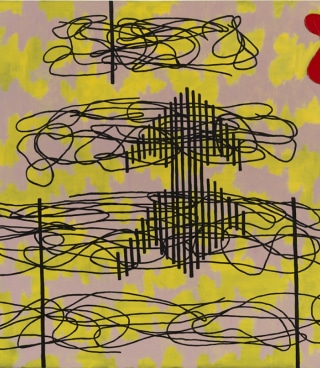Jonathan Lasker: The 80s
Timothy Taylor Gallery is pleased to announce an exhibition of paintings from the 1980s by the American artist Jonathan Lasker.
In a career spanning over thirty years Lasker has addressed the question of how painting might progress after Minimalism. Through his distinctive approach to abstraction, the artist chose to stand up to the finitude of Modernism at a time when painting was under attack. Lasker’s particular commitment to the medium and its history, coupled with an optimism for its future, has proven hugely influential to younger generations who have been similarly reluctant to leave painting for dead.
Central to his investigation has been the re-examination of picture making itself. Lasker’s is essentially a dialectical approach. Gestural elements are opposed with backgrounds which are at times geometric and at others decorative, to create figure/ground relationships, spatial depth and movement. Using paint in a manner reminiscent of collage, the artist ‘detaches’ and repeats motifs. This use of motifs as ready-mades or givens enforces the sense of them being a vocabulary constituting an ongoing discourse.
From the outset Lasker has searched for a way out of action painting, while working against a conceptual critique. Having attended the California Institute of Arts in the mid 1970s, a hotbed of Conceptualism, Lasker was challenged to find a new approach to making paintings. This entailed re-thinking the use of gesture.
Clyfford Still’s practice of re-painting works and making ‘replicas’, which upset the expectations of action painting and notions of uniqueness, can be viewed in parallel to Lasker’s early development. Robert Ryman’s tendency for adding thickly painted signatures to his reductive and monochrome compositions also relates to Lasker’s own method of including abstracted tags that seem linguistic.
In the mid 1980s Lasker’s compositions were increasingly animated and his palette at its most vibrant. The single line extended into a scribble, elevated to the status of a significant gesture, became his favourite motif. This is evidenced in the title of Cosmic Shorthand (1988), which reaffirms the graphic qualities of the linear elements in this composition.
Lasker’s paintings make us aware of how we look at art; they function as image kits for viewers to assemble and make sense of in their own minds. By emphasising painting’s constituent elements, most notably the differentiation between figure and ground, Lasker demonstrates not only the limitless possibilities inherent in the most reductive of visual vocabularies, but also reaffirms the medium’s ongoing vitality and currency in contemporary art practice.
Jonathan Lasker was born in 1948 in Jersey City, New Jersey. He attended the School of Visual Arts in New York and CalArts in Valencia, California in the late 1970s. Lasker has exhibited internationally since the early 1980s and his work is in private and public collections worldwide, including the Eli Broad Foundation, Los Angeles, USA; Hirschhorn Museum, Washington, D.C., USA; Museum Ludwig, Cologne, Germany; Moderna Museet, Stockholm, Sweden; MoMA, New York, USA; Centre Pompidou, Paris, France; Reina Sofia, Madrid, Spain; Whitney Museum of American Art, New York, USA and Museo de Arte Contemporaneo, Seville, Spain.






